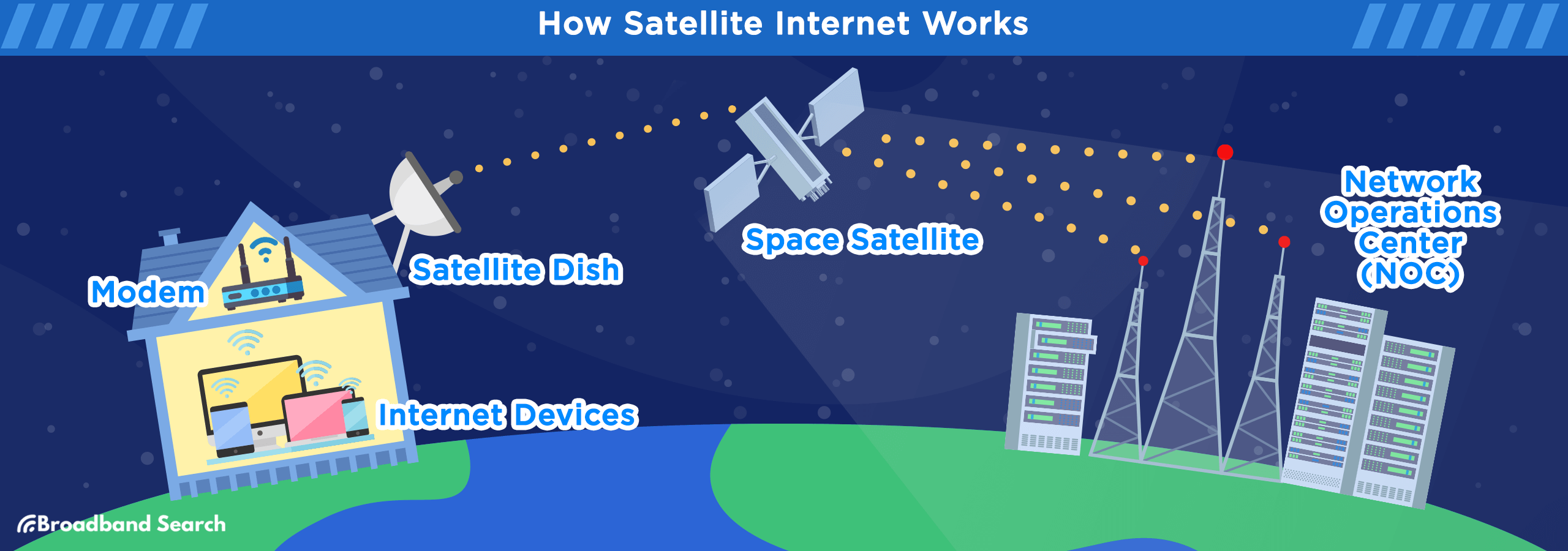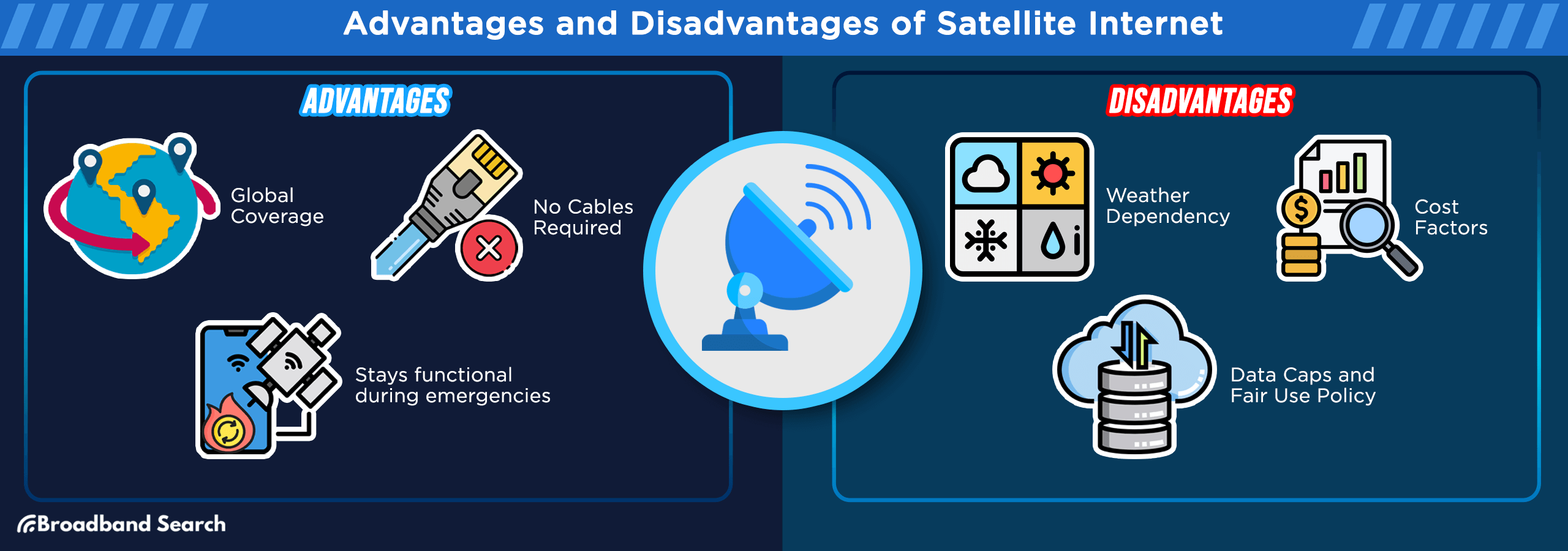If you live in a city, you probably have plenty of internet options. Fiber, cable, or DSL are usually just a call away. But for millions of households in rural or remote areas, reliable internet connectivity isn't a given. That's where satellite internet comes in.
Instead of relying on underground cables, satellite internet beams signals from satellites orbiting Earth to a dish at your home. It’s a game-changer for rural families, travelers, and anyone in a remote location who needs to stay connected.
This guide will walk you through how satellite internet works, its pros and cons, and whether it's the right choice for you.

Key Takeaways
- Satellite internet provides broadband access via signals beamed from satellites orbiting Earth, making it ideal for rural and remote areas where wired connections are unavailable.
- The system works by sending data from your device to a satellite, down to a ground station connected to the internet, and then back through the same path.
- Major providers include Starlink, which uses low Earth orbit (LEO) satellites for lower latency, and HughesNet and Viasat, which use geostationary (GEO) satellites.
- While satellite internet offers near-universal coverage, it can be affected by weather and has higher latency than fiber or cable, which can be a drawback for online gaming or real-time video calls.
What Is Satellite Internet?
At its core, satellite internet is exactly what it sounds like: internet delivered from satellites in space. Unlike fiber or cable, which require miles of physical wires to reach your home, it uses orbiting satellites to bring a connection to even the most remote locations.
For many rural residents, satellite internet is the only way to get a reliable broadband connection. While wired connections like those from CNET's top-rated providers are usually faster, satellite ensures you’re not left out of the digital world.
How Does Satellite Internet Work?
The process might sound complex, but it's really just a four-step relay:

- When you click on a website, your computer sends a request to your modem and router, which is connected to a satellite dish outside your home.
- The dish beams this request up to a satellite orbiting Earth.
- The satellite relays the request down to a ground station, which connects to the wider internet.
- To load the website, data makes the same trip in reverse—from the ground station to the satellite, back to your dish, and finally to your screen.
It's important to know that not all satellites are the same. Providers like HughesNet and Viasat use geostationary (GEO) satellites positioned about 22,000 miles above Earth. This great distance can create noticeable lag, or latency. Newer providers like Starlink use low Earth orbit (LEO) satellites, which are only a few hundred miles up. This closer proximity means less lag and faster speeds, making it a better option for video calls and streaming.
How to Get Satellite Internet
Getting set up with satellite internet is a straightforward process.
- Check Availability: The first step is to check which providers are available in your area. Go to the provider's website and enter your address to confirm you're within their coverage zone.
- Choose a Provider: The main providers today are Starlink, HughesNet, Viasat, and EarthLink. Compare their plans, speeds, data caps, and costs to find the best fit for your needs.
- Order and Install Hardware: You'll need a satellite dish and a compatible modem/router. Some providers, like Starlink, require you to buy the kit upfront, while others may include the hardware cost in your monthly bill. Installation can often be a DIY project, but some providers may require a technician.
- Get Connected: Once the dish is installed and has a clear view of the sky, you just need to connect your devices and you’re ready to go.
How Much Does Satellite Internet Cost?
Satellite internet is generally more expensive than cable or DSL. Monthly plans typically range from $65 to $120. You'll also have one-time upfront costs for equipment. Starlink's kit, for example, is around $599. Other providers might charge separate installation fees or monthly equipment rental fees.
Data caps are another important factor. Some providers limit how much high-speed data you can use per month before slowing your connection, while others, like Starlink, currently offer unlimited data. Always read the fine print to understand exactly what you're paying for.
Satellite Internet Providers
Your experience will depend heavily on the provider you choose. Here’s a quick comparison of the major players:
| Provider | Price Range (Monthly) | Speeds | Latency | Equipment Cost | Data Policy |
|---|---|---|---|---|---|
| Starlink | ~$120 | 20-100 Mbps | Low | $599 upfront | Unlimited |
| HughesNet | $65 - $180 | 50-100 Mbps | High | Lease or purchase | Data caps |
| Viasat | $70 - $120 | Up to 150 Mbps | High | Lease or purchase | Data caps |
| EarthLink | Varies | Varies | Varies | Varies | Varies |
Note: Amazon's Project Kuiper and OneWeb are also entering the market, which should increase competition and improve options in the near future.

Advantages of Satellite Internet
The benefits of satellite internet are significant, especially if you live outside of traditional service areas.
- Universal Availability: The main advantage is its reach. As long as you have a clear view of the sky, you can likely get service, regardless of how remote your location is.
- Independence from Ground Infrastructure: It doesn’t rely on phone lines, cell towers, or underground cables, making it a robust solution.
- Disaster-Proof: In emergencies like floods or storms that damage ground-based networks, satellite internet often remains operational, providing a critical communication lifeline.
Challenges and Limitations of Satellite Internet
Despite its benefits, satellite internet has its drawbacks.
- Weather Interference: Heavy rain, snow, or even dense cloud cover can disrupt your signal and slow down your service.
- Higher Latency: The distance data travels results in higher latency compared to fiber or cable. This can be frustrating for competitive online gaming or real-time video conferencing.
- Higher Cost: Both the monthly plans and upfront equipment costs are typically more expensive than wired internet options.
- Data Caps: Many providers enforce data caps, which can limit activities like streaming movies or downloading large files.
Who Is Satellite Internet Best For?
Satellite internet is the ideal solution for:
- Rural Households: If you live in an area without access to cable or fiber, satellite may be your only high-speed option.
- Travelers and RV Owners: Mobile satellite services, like Starlink's Roam plan, offer flexibility for people on the go.
- Backup Connectivity: For those who can't afford to be offline, satellite can serve as a reliable backup if your primary internet connection fails.
However, it may not be the best fit for competitive gamers or large households that stream 4K video on multiple devices simultaneously, as the latency and potential data caps can be limiting.
Closing the Connectivity Gap
For millions of people, satellite internet is more than just an alternative—it’s an essential link to the digital world. While it may not always match the speed or price of wired networks, it prevents many communities from being left behind.
As technology improves with new LEO constellations from companies like Starlink and Amazon, satellite internet is becoming faster and more reliable. It’s a key part of bridging the digital divide and ensuring everyone has a way to connect.
FAQ
Is a contract required for satellite internet?
It depends on the provider. Some, like Starlink, offer month-to-month flexibility, while others may require a one- or two-year contract. It’s important to check the terms before signing up.
Can I use satellite internet on a boat or in an RV?
Yes! Many providers now offer mobile plans designed for boats, RVs, and other travelers. These plans often come with portable equipment to help you stay connected on the move.
How reliable is satellite internet?
Modern satellite internet is more reliable than ever, but it can still be affected by severe weather. LEO systems like Starlink are generally more stable than older GEO systems, but even they can slow down during peak usage hours.

